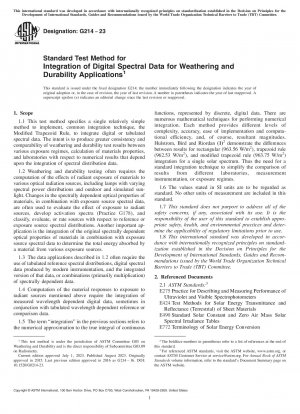ASTM G214-23
Standard Test Method for Integration of Digital Spectral Data for Weathering and Durability Applications
- Standard No.
- ASTM G214-23
- Release Date
- 2023
- Published By
- American Society for Testing and Materials (ASTM)
- Latest
- ASTM G214-23
- Scope
- 1.1 This test method specifies a single relatively simple method to implement, common integration technique, the Modified Trapezoid Rule, to integrate digital or tabulated spectral data. The intent is to produce greater consistency and comparability of weathering and durability test results between various exposure regimes, calculation of materials properties, and laboratories with respect to numerical results that depend upon the integration of spectral distribution data. 1.2 Weathering and durability testing often requires the computation of the effects of radiant exposure of materials to various optical radiation sources, including lamps with varying spectral power distributions and outdoor and simulated sunlight. Changes in the spectrally dependent optical properties of materials, in combination with exposure source spectral data, are often used to evaluate the effect of exposure to radiant sources, develop activation spectra (Practice G178), and classify, evaluate, or rate sources with respect to reference or exposure source spectral distributions. Another important application is the integration of the original spectrally dependent optical properties of materials in combination with exposure source spectral data to determine the total energy absorbed by a material from various exposure sources. 1.3 The data applications described in 1.2 often require the use of tabulated reference spectral distributions, digital spectral data produced by modern instrumentation, and the integrated version of that data, or combinations (primarily multiplication) of spectrally dependent data. 1.4 Computation of the material responses to exposure to radiant sources mentioned above require the integration of measured wavelength dependent digital data, sometimes in conjunction with tabulated wavelength dependent reference or comparison data. 1.5 The term “integration” in the previous sections refers to the numerical approximation to the true integral of continuous functions, represented by discrete, digital data. There are numerous mathematical techniques for performing numerical integration. Each method provides different levels of complexity, accuracy, ease of implementation and computational efficiency, and, of course, resultant magnitudes. Hulstrom, Bird and Riordan (1)2 demonstrate the differences between results for rectangular (963.56 W/m2 ), trapezoid rule (962.53 W/m2 ), and modified trapezoid rule (963.75 W/m2 ) integration for a single solar spectrum. Thus the need for a standard integration technique to simplify the comparison of results from different laboratories, measurement instrumentation, or exposure regimes. 1.6 The values stated in SI units are to be regarded as standard. No other units of measurement are included in this standard. 1.7 This standard does not purport to address all of the safety concerns, if any, associated with its use. It is the responsibility of the user of this standard to establish appropriate safety, health, and environmental practices and determine the applicability of regulatory limitations prior to use. 1.8 This international standard was developed in accordance with internationally recognized principles on standardization established in the Decision on Principles for the Development of International Standards, Guides and Recommendations issued by the World Trade Organization Technical Barriers to Trade (TBT) Committee.
ASTM G214-23 Referenced Document
- ASTM E275 Standard Practice for Describing and Measuring Performance of Ultraviolet, Visible, and Near-Infrared Spectrophotometers
- ASTM E424 Standard Test Methods for Solar Energy Transmittance and Reflectance (Terrestrial) of Sheet Materials
- ASTM E490 Standard Solar Constant and Zero Air Mass Solar Spectral Irradiance Tables
- ASTM E772 Standard Terminology Relating to Solar Energy Conversion
- ASTM E927 Standard Specification for Solar Simulation for Terrestrial Photovoltaic Testing
- ASTM E971 Standard Practice for Calculation of Photometric Transmittance and Reflectance of Materials to Solar Radiation
- ASTM E972 Standard Test Method for Solar Photometric Transmittance of Sheet Materials Using Sunlight
- ASTM E973 Test Method for Determination of the Spectral Mismatch Parameter Between a Photovoltaic Device and a Photovoltaic Reference Cell
- ASTM G113 Standard Terminology Relating to Natural and Artificial Weathering Tests of Nonmetallic Materials
- ASTM G130 Standard Test Method for Calibration of Narrow- and Broad-Band Ultraviolet Radiometers Using a Spectroradiometer
- ASTM G138 Standard Test Method for Calibration of a Spectroradiometer Using a Standard Source of Irradiance
- ASTM G151 Standard Practice for Exposing Nonmetallic Materials in Accelerated Test Devices that Use Laboratory Light Sources
- ASTM G173 Standard Tables for Reference Solar Spectral Irradiances: Direct Normal and Hemispherical on 37° Tilted Surface
- ASTM G177 Standard Tables for Reference Solar Ultraviolet Spectral Distributions: Hemispherical on 37 Tilted Surface*, 2024-04-21 Update
- ASTM G178 Standard Practice for Determining the Activation Spectrum of a Material (Wavelength Sensitivity to an Exposure Source) Using the Sharp Cut-On Filter or Spectrographic Technique
- ASTM G197 Standard Table for Reference Solar Spectral Distributions: Direct and Diffuse on 20° Tilted and Vertical Surfaces
- ASTM G207 Standard Test Method for Indoor Transfer of Calibration from Reference to Field Pyranometers
ASTM G214-23 history
- 2023 ASTM G214-23 Standard Test Method for Integration of Digital Spectral Data for Weathering and Durability Applications
- 2016 ASTM G214-16 Standard Test Method for Integration of Digital Spectral Data for Weathering and Durability Applications
- 2015 ASTM G214-15 Standard Test Method for Integration of Digital Spectral Data for Weathering and Durability Applications
